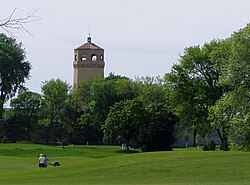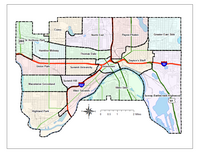Highland Park, Saint Paul
| Highland Park | |
|---|---|
| Neighborhood | |

The old Highland Park Water Tower, listed on the National Register of Historic Places.
|
|
 Map of neighborhoods in the city of Saint Paul, Minnesota |
|
| Country | United States |
| State | Minnesota |
| County | Ramsey |
| City | Saint Paul |
| Area | |
| • Total | 6.038 sq mi (15.64 km2) |
| Population (2010) | |
| • Total | 24,589 |
| • Density | 4,100/sq mi (1,600/km2) |
| Time zone | CST (UTC-6) |
| • Summer (DST) | CDT (UTC-5) |
| ZIP code | 55116 |
| Area code(s) | 651 |
| Website | http://www.highlanddistrictcouncil.org/ |
Highland Park is a neighborhood in the southwestern corner of Saint Paul, Minnesota, United States. Also known as Highland District Council (District 15), it lies along the Mississippi River just north of Fort Snelling and across the river from Minneapolis-Saint Paul International Airport. According to the 2000 census Highland Park had a population of 23,202.
The Highland District Council is one of seventeen neighborhood district councils in Saint Paul. The district councils were formed in 1975 to advise the Saint Paul City Council on issues related to the development of its area as well as city and state issues. The HDC Board of Directors is composed of community volunteers elected to serve two-year terms.
A veteran of the Mexican-American War, William Finn was the first white person to settle in Highland Park permanently in 1848. He was granted a large portion of land along the Mississippi River and built a house on the land that the University of St. Thomas now occupies. During this time, much of the Highland Park area was encompassed by the Fort Snelling reservation but by the mid 1850s the government opened up most of that land for sale. Growth in the area had pressured the government into making this move and in 1854, approximately 5,000 acres (20 km²) were sold at about $1.25 per acre. This sale opened up the area for settlement, and the area in Ramsey County that was first settled became the last in Saint Paul to be densely populated.
In 1925, the Ford Motor Company opened the Twin Cities Assembly Plant (originally for Model T automobiles) in Highland Park and caused much of the remaining farm land in the area to be subdivided for the auto workers. Soon after, in 1927, the Intercity Bridge was built to carry workers over the river from Minneapolis to work in the plant. Construction started in 1927 on the Highland Park Water Tower, a structure that still stands today and has become a landmark on the highest part of Saint Paul.
...
Wikipedia
